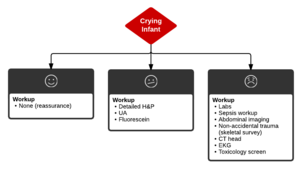We need you! Join our contributor community and become a WikEM editor through our open and transparent promotion process.
Crying infant
From WikEM
Contents
Background
- Mean duration of crying is approximately 2 hrs/day for the first 6 wks[1]
- This decreases to 72 mins/day by age 10-12 wks
- As many as 43% of infants experience excessive crying[2]
- 5% of crying infants are found to have underlying disease[3]
Differential Diagnosis
Crying Infant
- Occult infection
- GI
- Intussusception
- GERD
- Incarcerated hernia
- Milk protein intolerance
- Anal fissure
- Ophtho
- Occult trauma
- Hair tourniquets (on extremities, penis)
- Non-accidental trauma
- Diaper pin
- Insect bites
- Burns in mouth
- Misc
- Colic
- Scorpion envenomation
- SVT
- Testicular torsion
- Drug exposure / overdose (commonly methamphetamine or cocaine)
- Drug withdrawal
Work-Up
- rule out badness above including shaken baby
- flourescein staining to rule out corneal abrasions
- fundoscopic exam
- rule out otitis
- examine all bones/joints to rule out fracture, osteo or septic joint
- inspect GU area
- Skeletal survey & head CT in suspected child abuse
- 4% benefit from change to soy formula
- rocking, warm compresses to belly feeding, frequent burping, diaper changes
Management
- If no underlying cause is found attempt the "5 Ss"
- Swaddling
- Side/Stomach position while awake
- Shhhhing to provide soothing sound
- Swinging the baby in parent's arms
- Sucking on breast or pacifier
See Also
References
- ↑ Wolke D, et al. Meta-analysis of fuss/cry durations and colic prevalence across countries. In: Proceedings of the 11th International Infant Cry Research Workshop. 8-10 June 2011. Zeist, The Netherlands.
- ↑ Reijneveld SA, et al. Excessive infant crying: the impact of varying definitions. Pediatrics. 2001; 108(4):893-897.
- ↑ Barr, RG. Colic and crying syndromes in infants. Pediatrics. 1998; 102(5):1282-1286.

